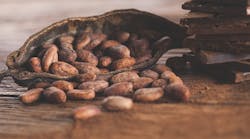Late in October, Reuters reported the Ivory Coast is on track for a record cocoa harvest in 2018/2019. The cocoa crop runs from October to March and is anticipated to hit a record 1.7 million tonnes, up from 1.5 million in the prior season.
This good news, however, is tempered by a potentially alarming communique published by the University of Arizona, reporting on the work of professor Judy Brown, a plant virologist in its College of Agriculture and Life Sciences. Brown focuses her work on a blight disease in West Africa that targets and kills cacao trees – a disease that is spreading rapidly.
Such is the world of cocoa, an ingredient still overwhelmingly created by its agricultural source and still overwhelmingly farmed by tiny, family-run farms in developing nations, which supply close to 90 percent of the world’s cocoa.
Big processors commit to sustainability
Mars Inc., one of the funding sources for Brown’s work, launched its “Sustainable in a Generation Plan” in 2017. Tucked within is its “Cocoa for Generations” plan, focused specifically on the cocoa supply chain. It places the interests of the smallhold famer at its center, the company says, in an effort to “build a new model for the cocoa supply chain.”
The company is investing $1 billion in its 10-year plan, which is committed to improving farmer income, protecting children and preserving forests.
Cargill Cocoa and Chocolate – which acquired ADM’s substantial cocoa business in 2015 – also plans to secure a “thriving cocoa sector for generations to come” with a “cocoa promise.” Its multi-pronged approach involves activities focused on improving farmer and community livelihoods, encompassing training and coaching, environmental protection, technology and innovation. In addition, the company says it wishes to build consumer confidence through a more transparent supply chain.
Olam Cocoa issued a pledge to achieve 100 percent traceable and sustainable cocoa volumes from its direct origination supply chain by 2020. The company, like others in the industry, is working on multiple issues, including efforts to combat the prevalence of child labor. One major effort involves pulling smallhold cocoa farmers out of poverty, not only by paying sustainable premiums to farmers but also channeling investment into social infrastructure such as building local schools.
Hershey Corp., which earlier this decade pledged to utilize sustainable cocoa throughout its supply chain by 2020, said last summer that 75 percent of its cocoa already was certified sustainable.
Cocoa sustainability is one portion of the company’s plans to make a positive difference in the world through its “Shared Goodness Promise.” This ambitious plan involves protecting biodiversity and safeguarding the natural environment, investing in brands that make a difference in the world, nourishing one million minds by 2020 and enhancing the lives of 10 million people.
Among brand marketing efforts, Hershey’s Kit Kat brand stands out, according to Daniel Granderson, market research analyst for Packaged Facts (www.packagedfacts.com). The product posted the largest gains in the past 10 years, says Granderson, due to its popularity among consumers under age 40, particularly Gen Z. He specifically calls the company’s marketing and branding efforts “brilliant” based on results to reach its target audiences, particularly noting its social media outreach.
Reaching new ‘heights’?
Forget endorphins and serotonin mood-lifters that kick into gear after ingesting chocolate; a more enhanced mood-altering confection could be on its way. The Specialty Food Assn. Trend-spotter Panel predicts legalized cannabis will hit the market in a variety of potential product pairings.
Chocolates are near the top of the list of edibles. Where recreational cannabis is legal, small companies already are marketing cannabis-infused chocolates with a fancy food feel to their wrappers. Some of the companies are Kiva Confections, MC Brands, CRFT Manufacturing, Wyld, Swifts Edibles and Dixie Elixirs & Edibles.
In fact, candy and chocolates account for the majority of the estimated $1 billion in sales of cannabis-infused food and drink products in the U.S. and Canada for 2017, according to BDS Analytics, with final sales figures for 2018 projected to reach $1.5 billion. Scientists have determined that chocolate and marijuana both exert a similar effect on our brains, so the combination could be a dizzying experience.


